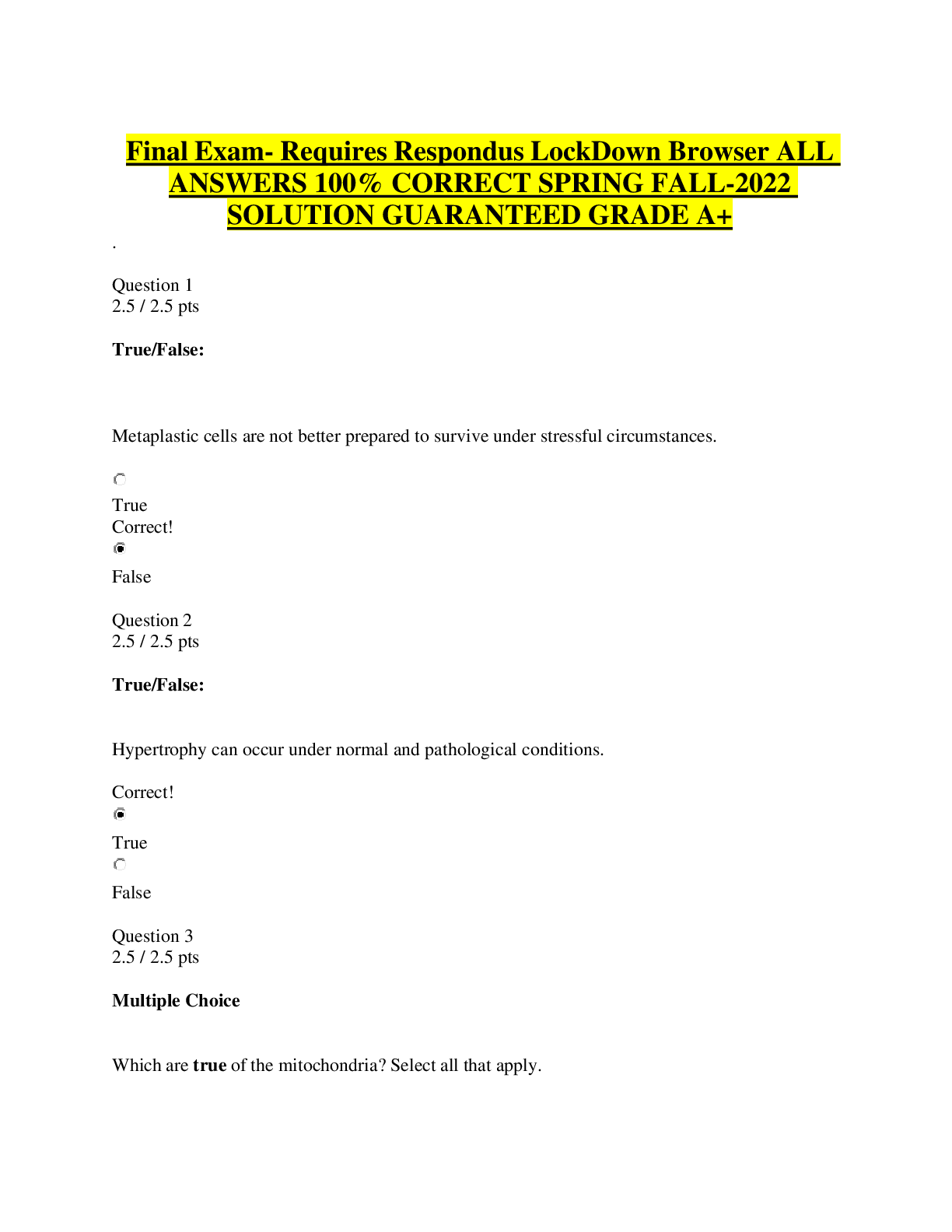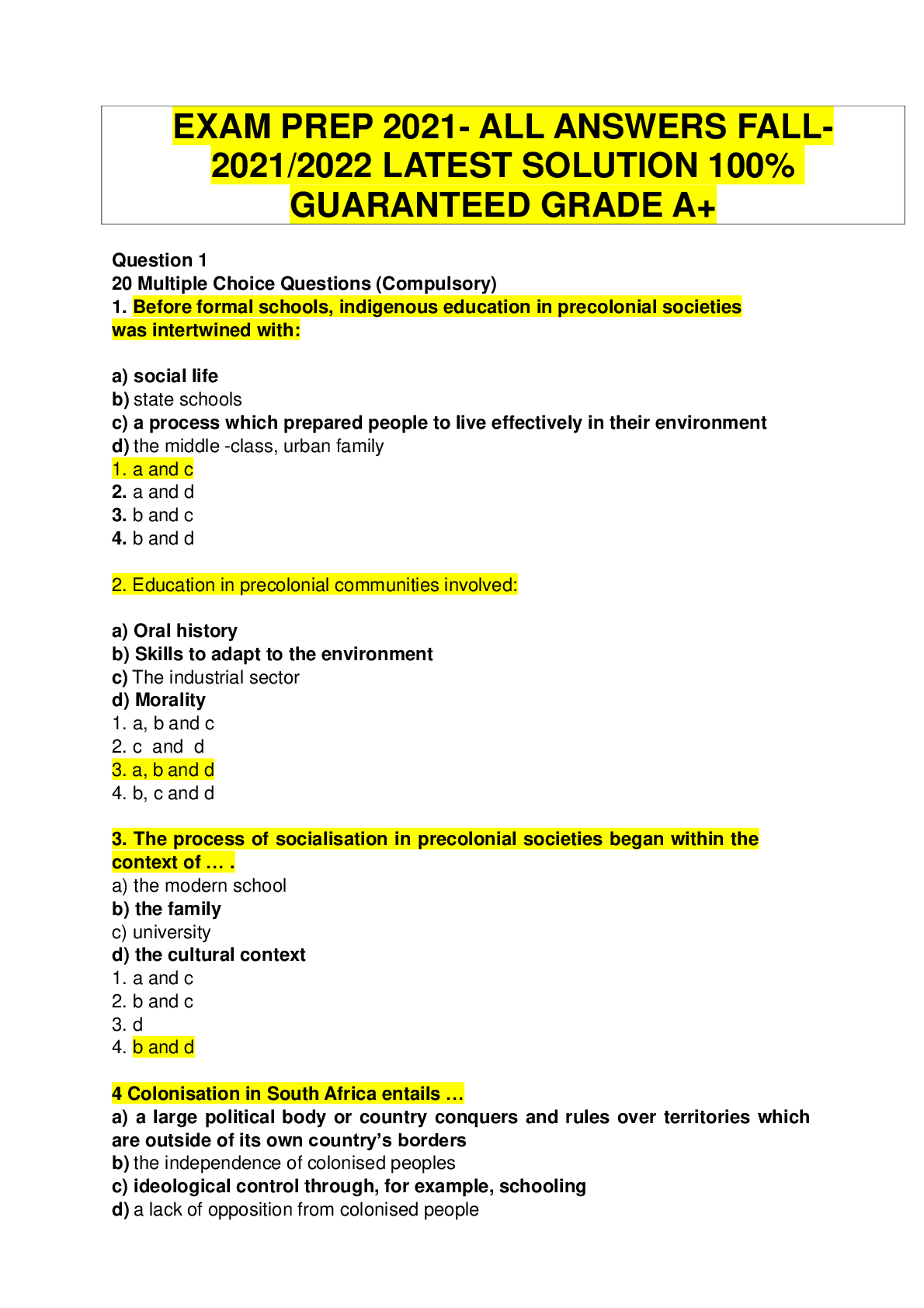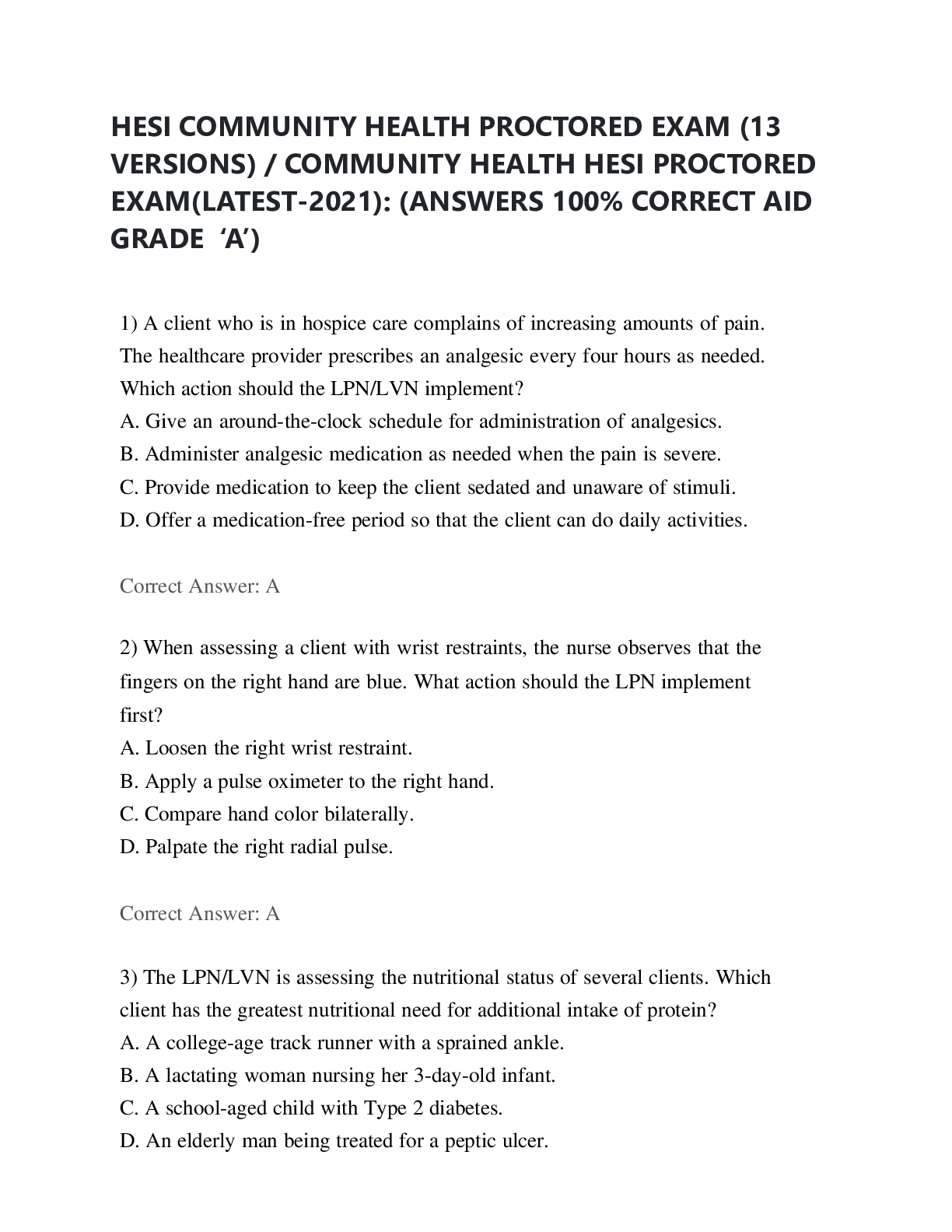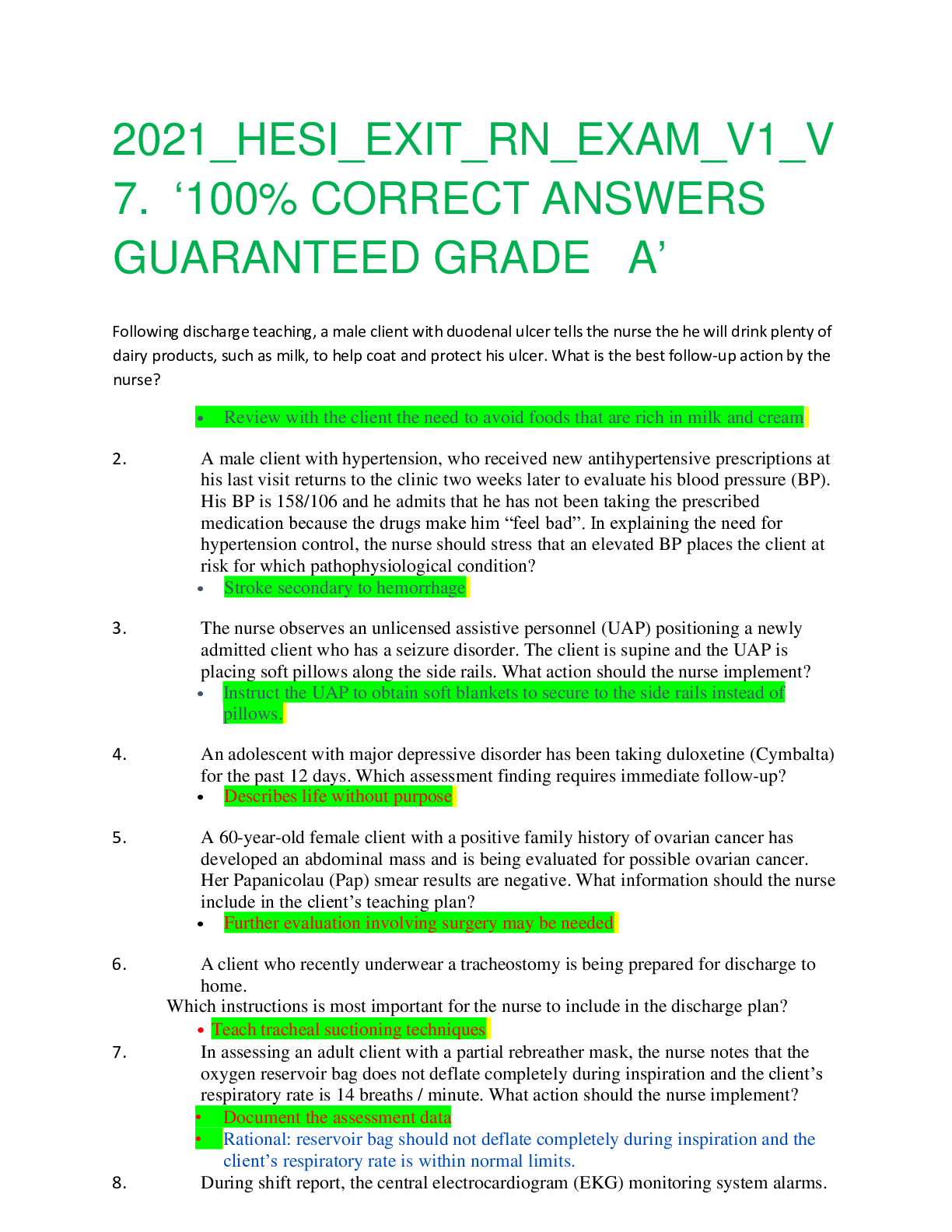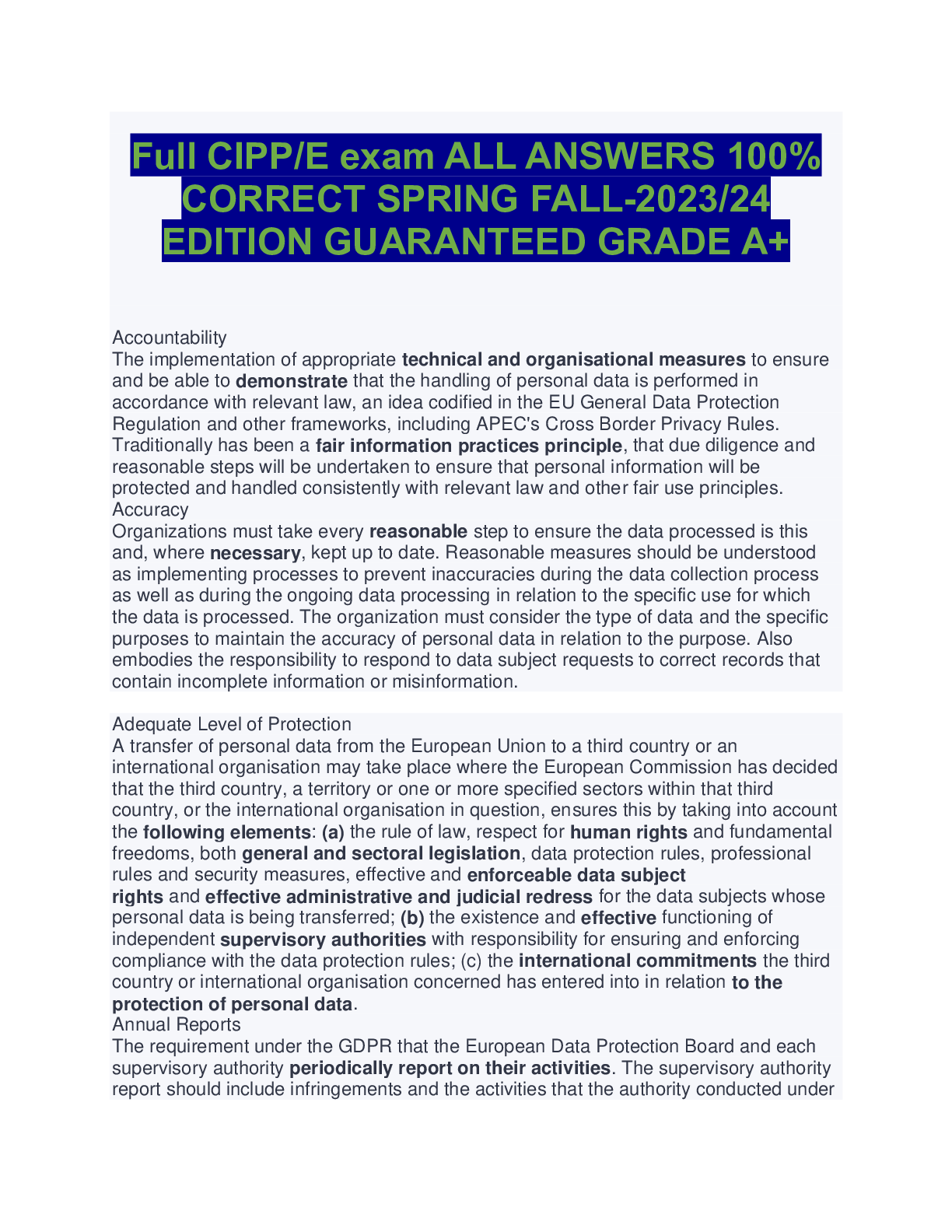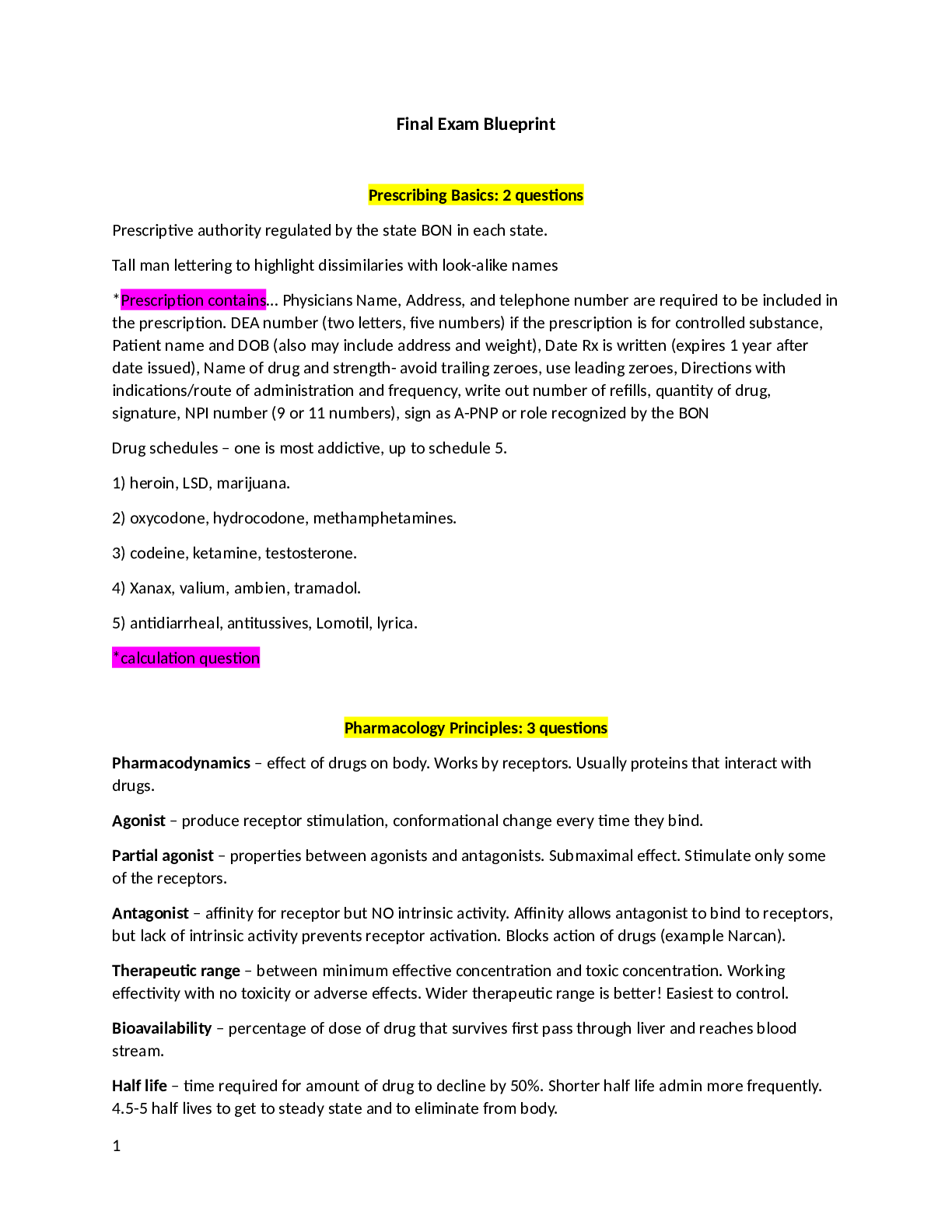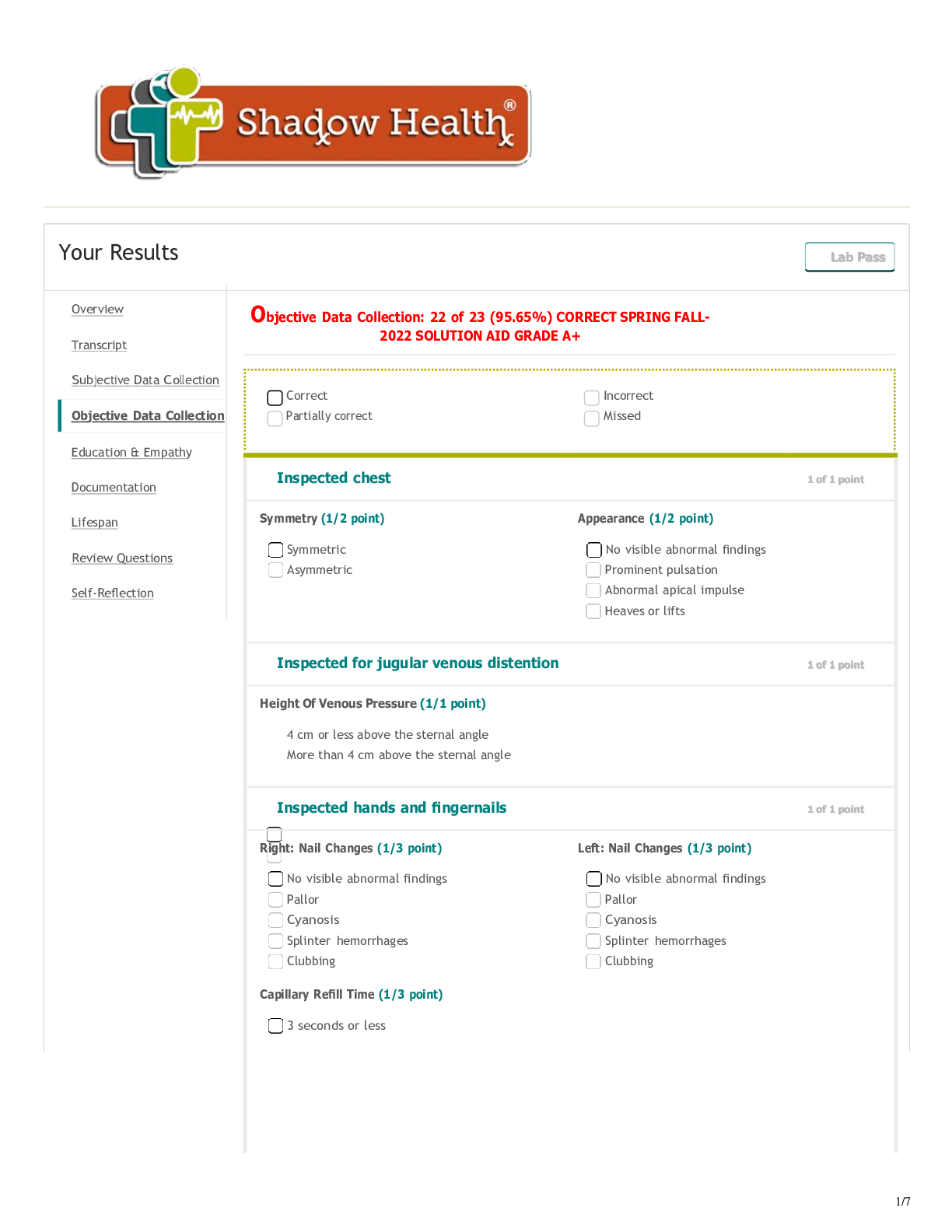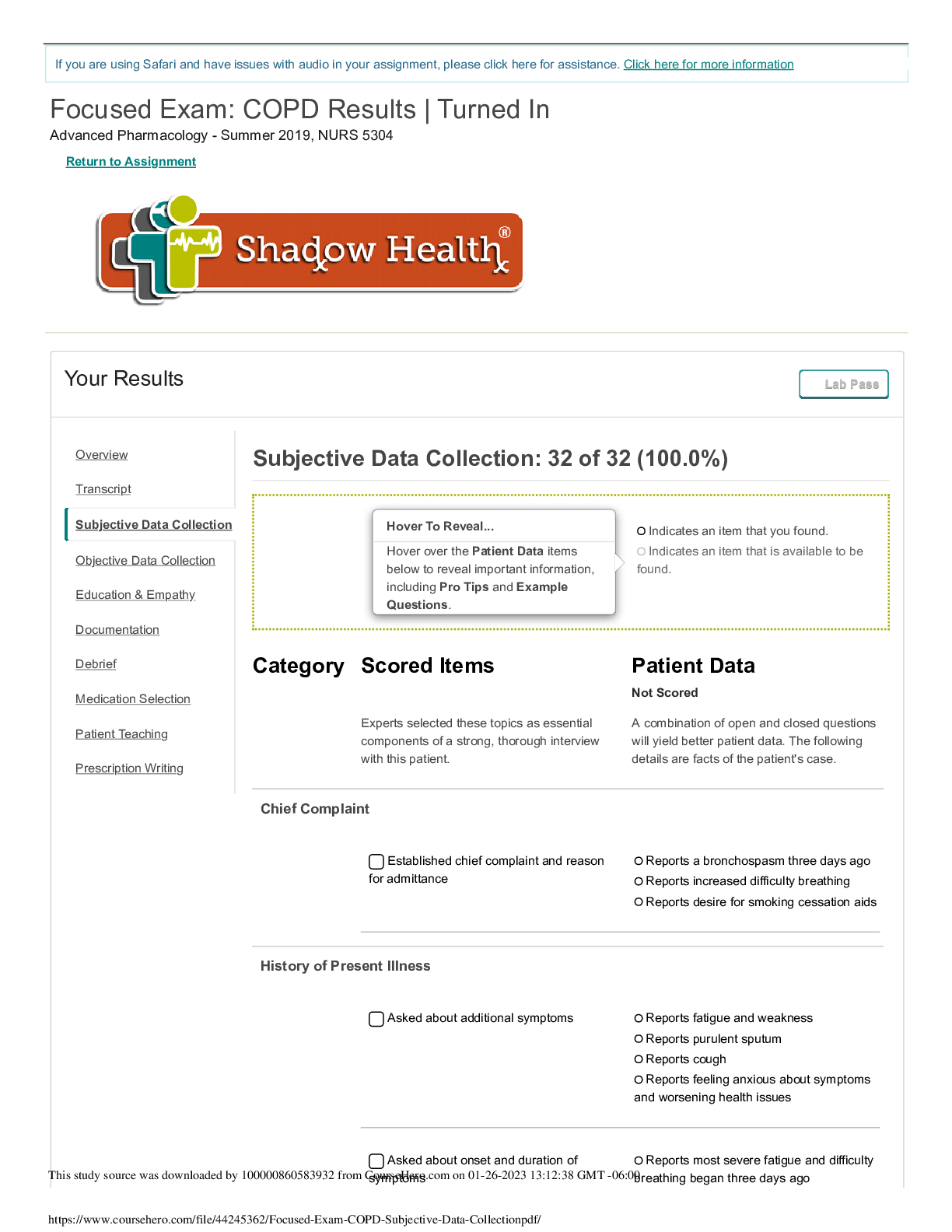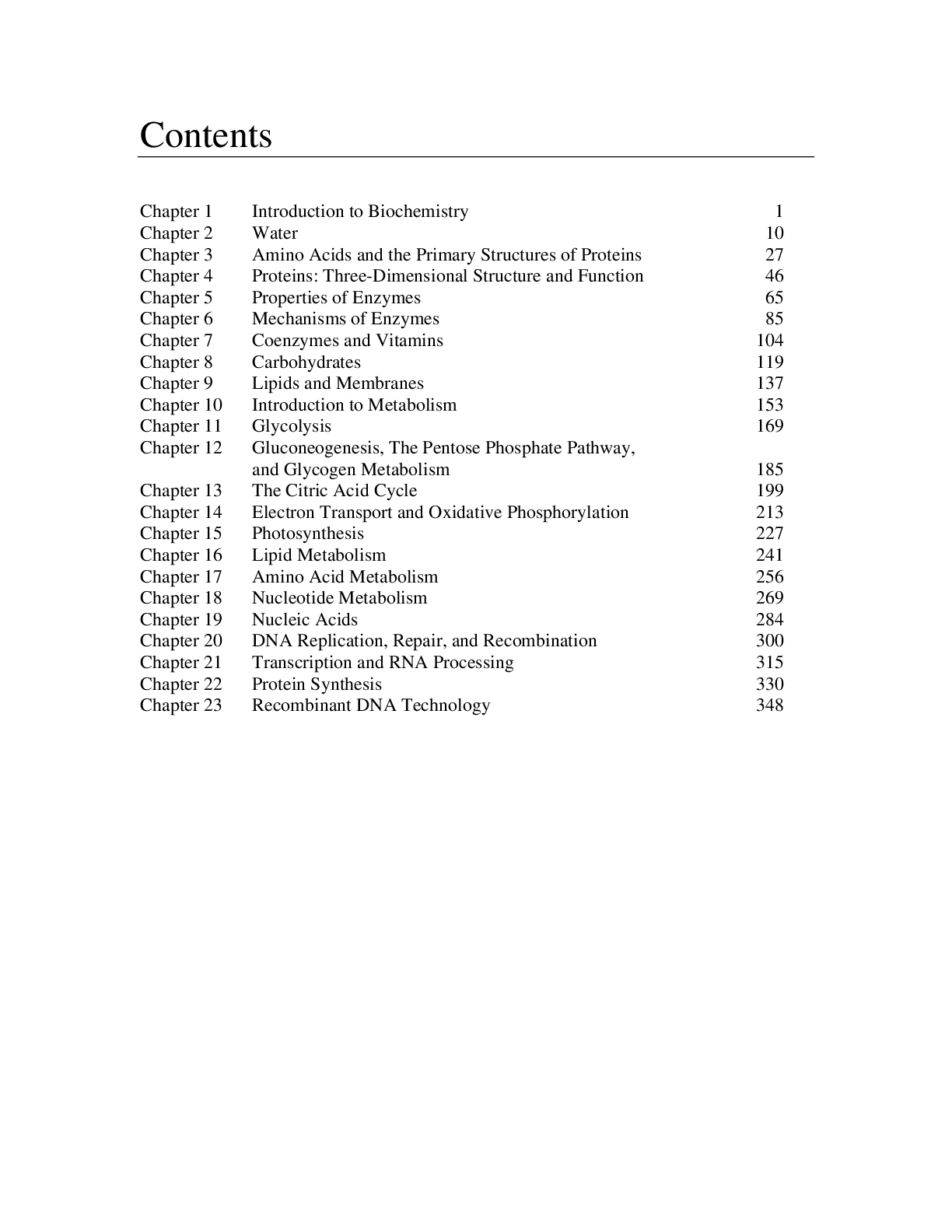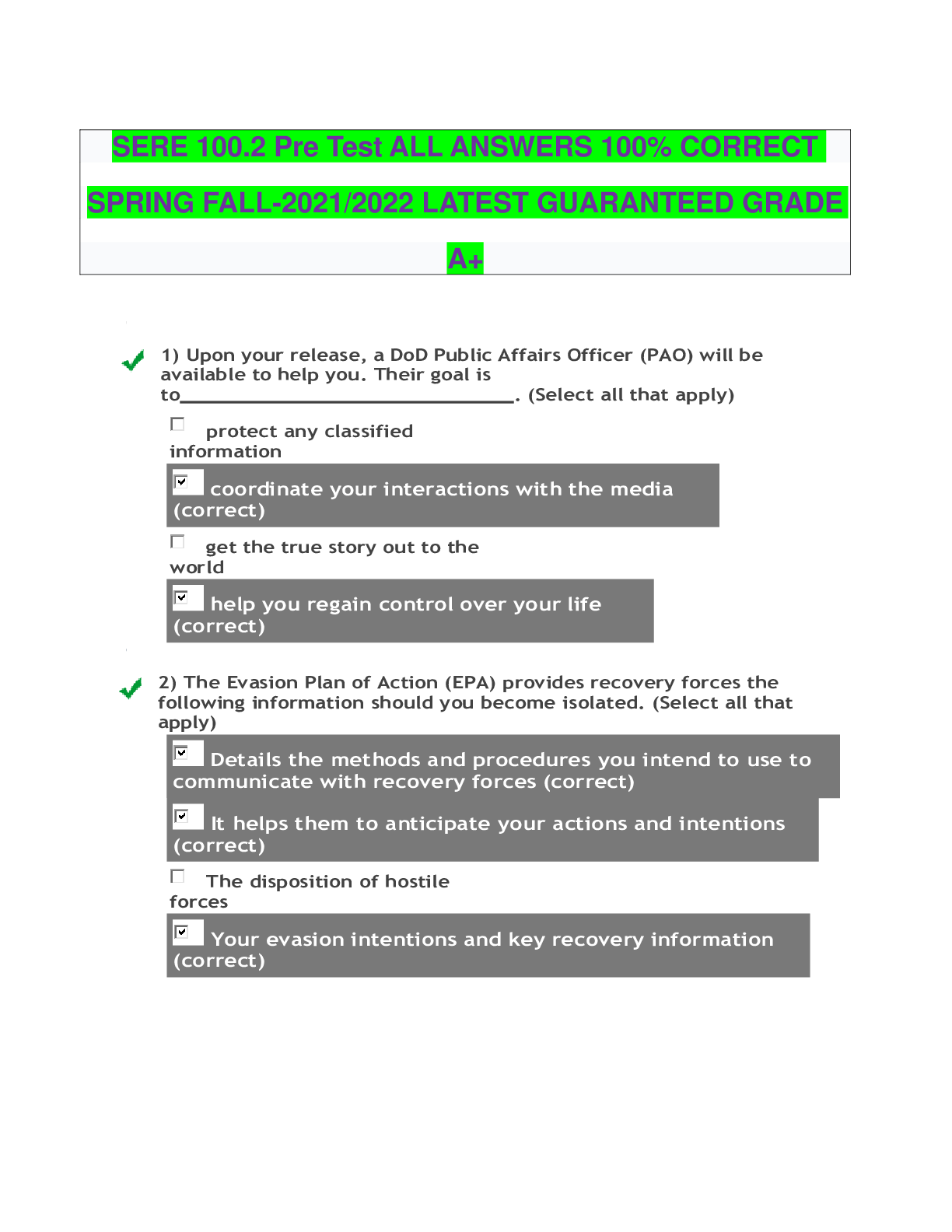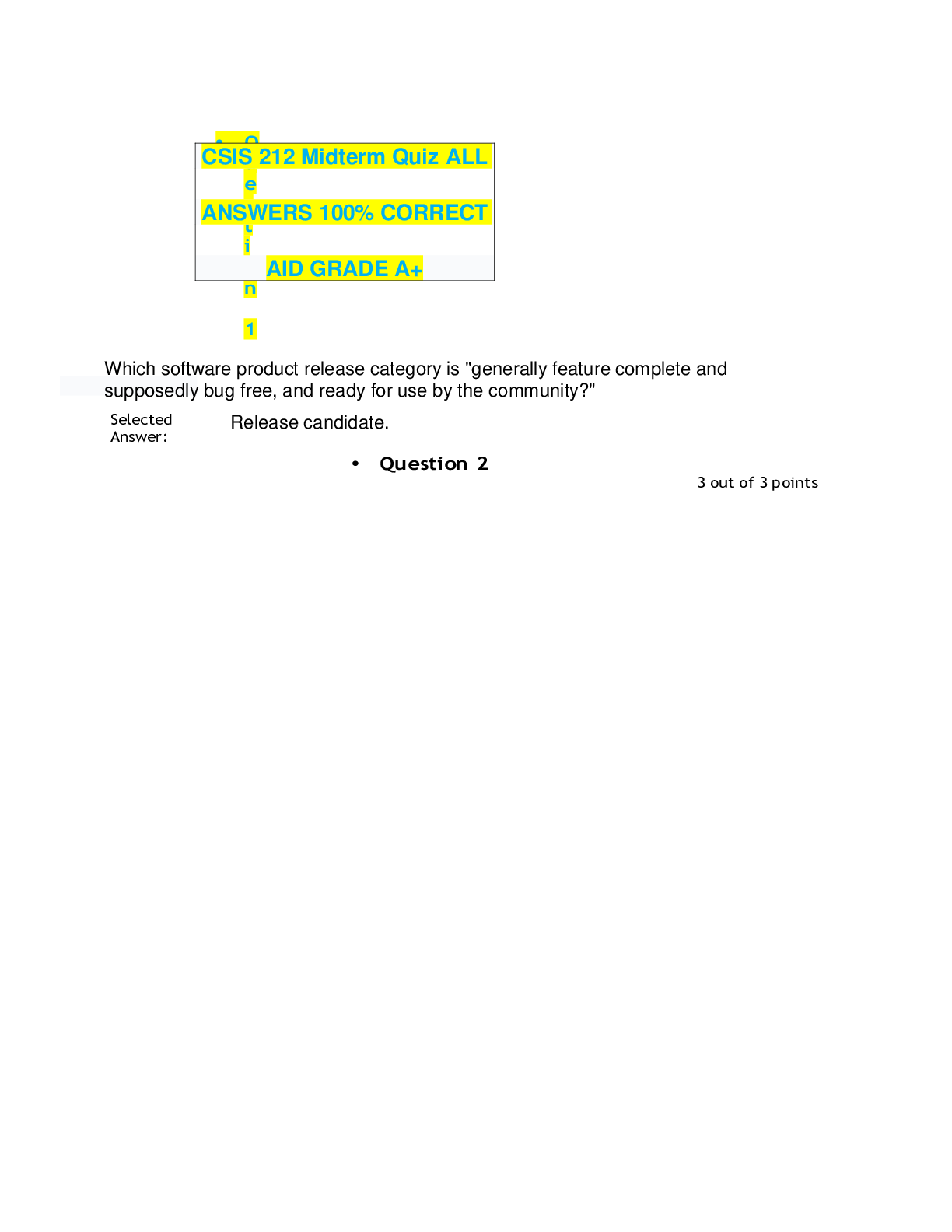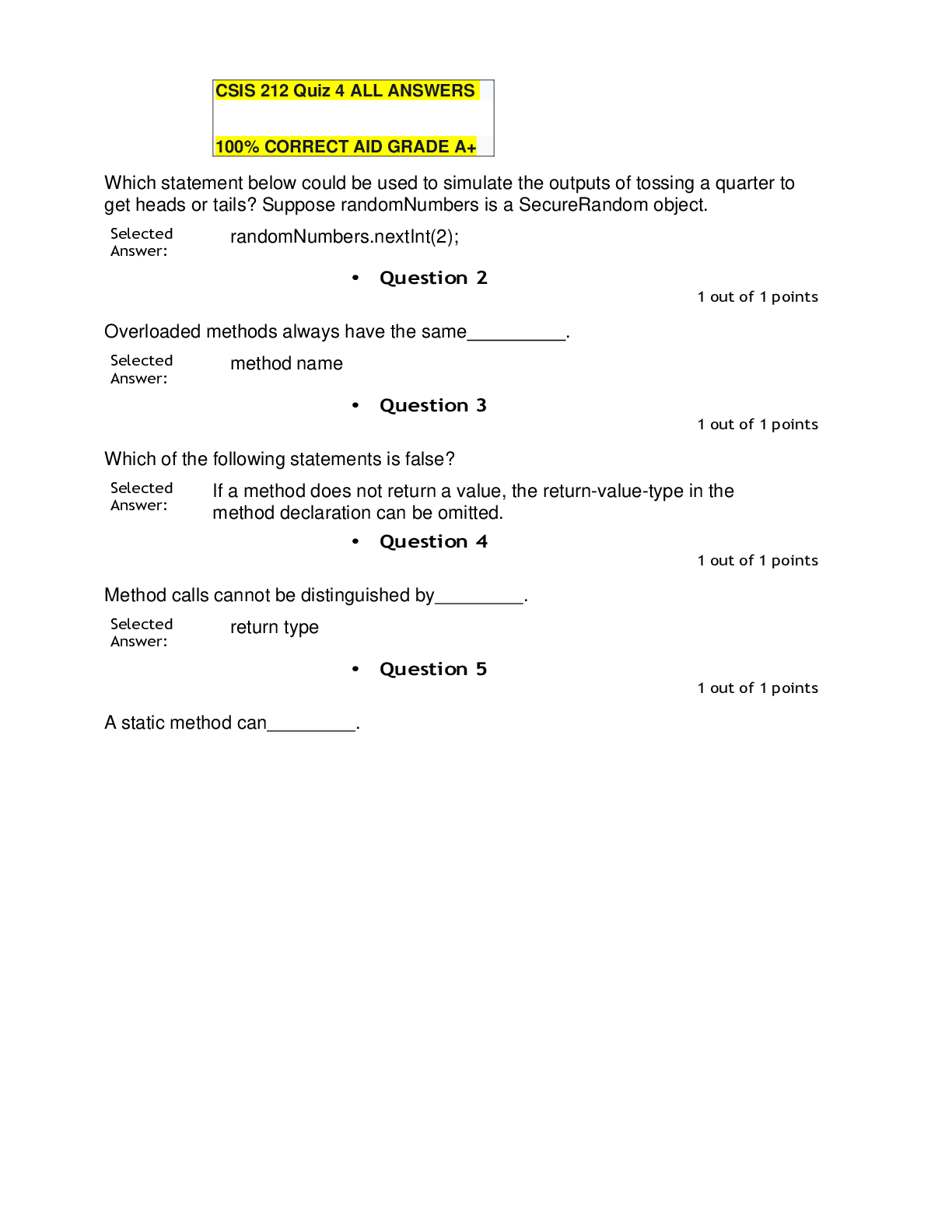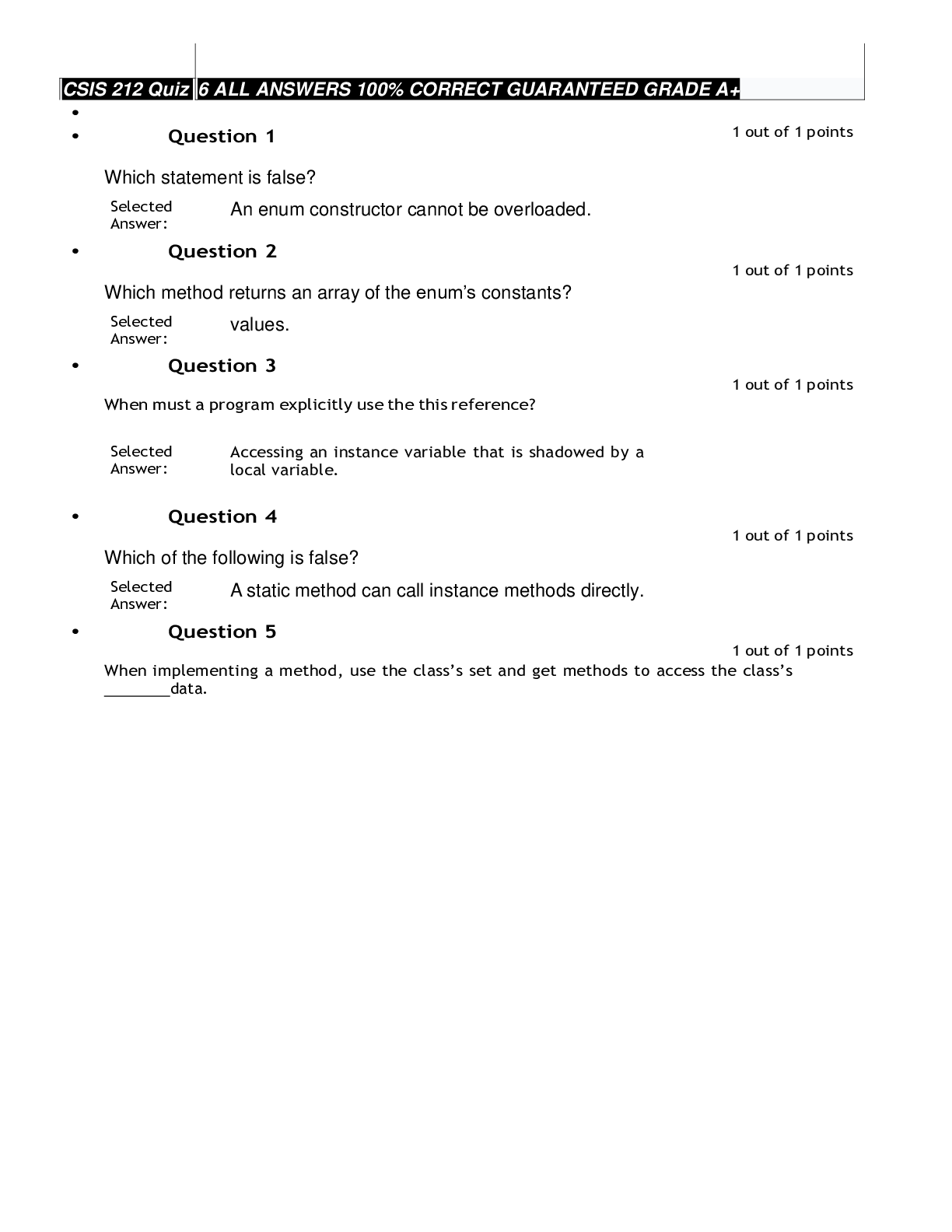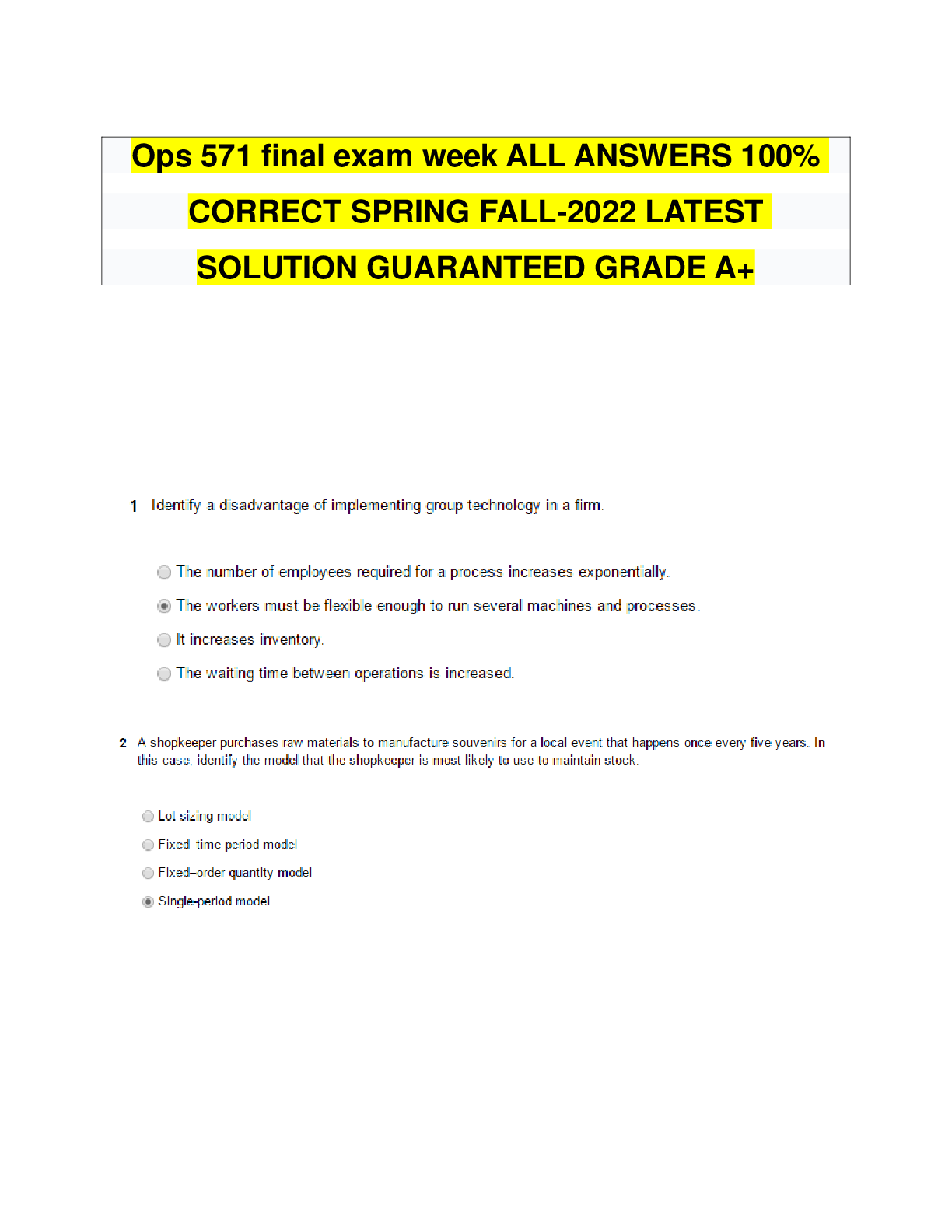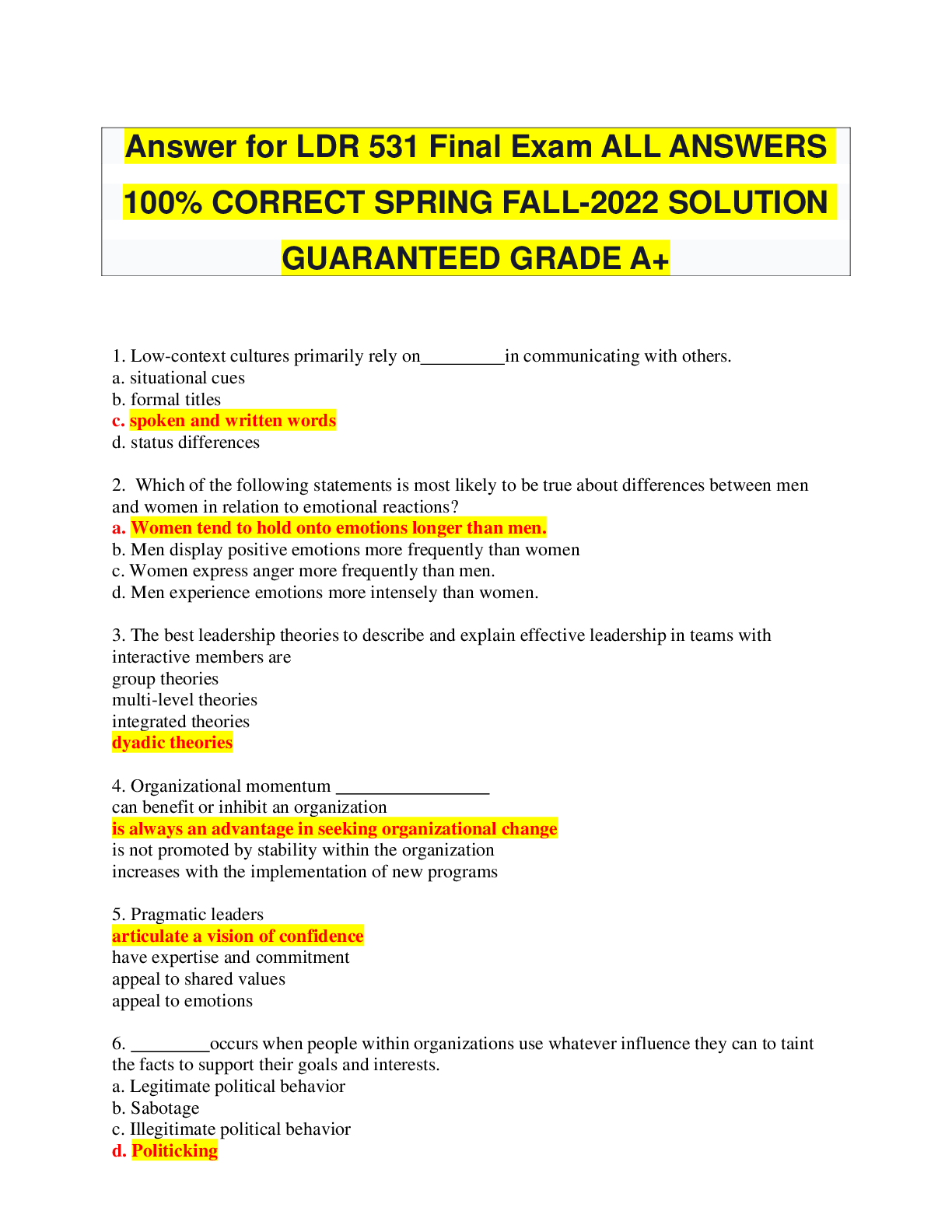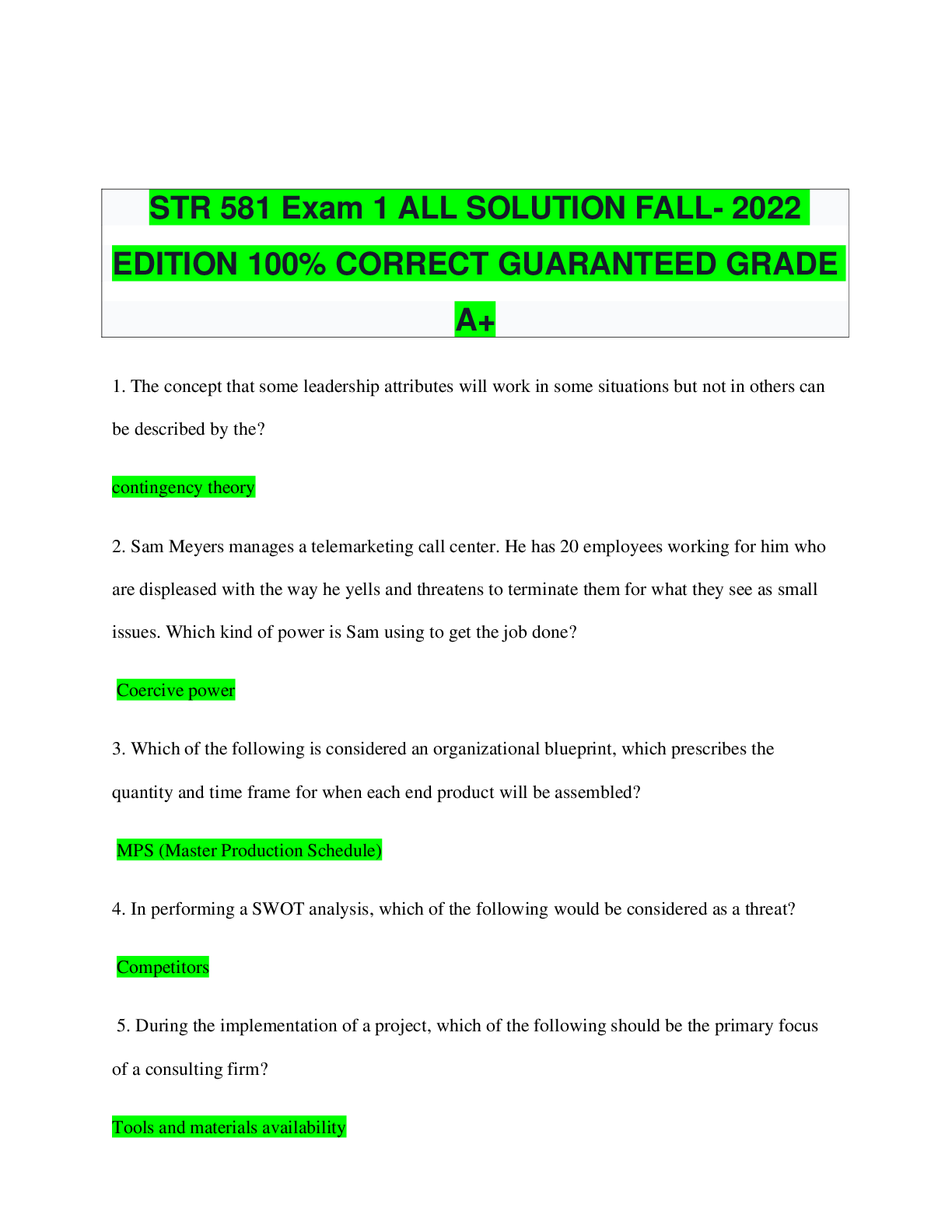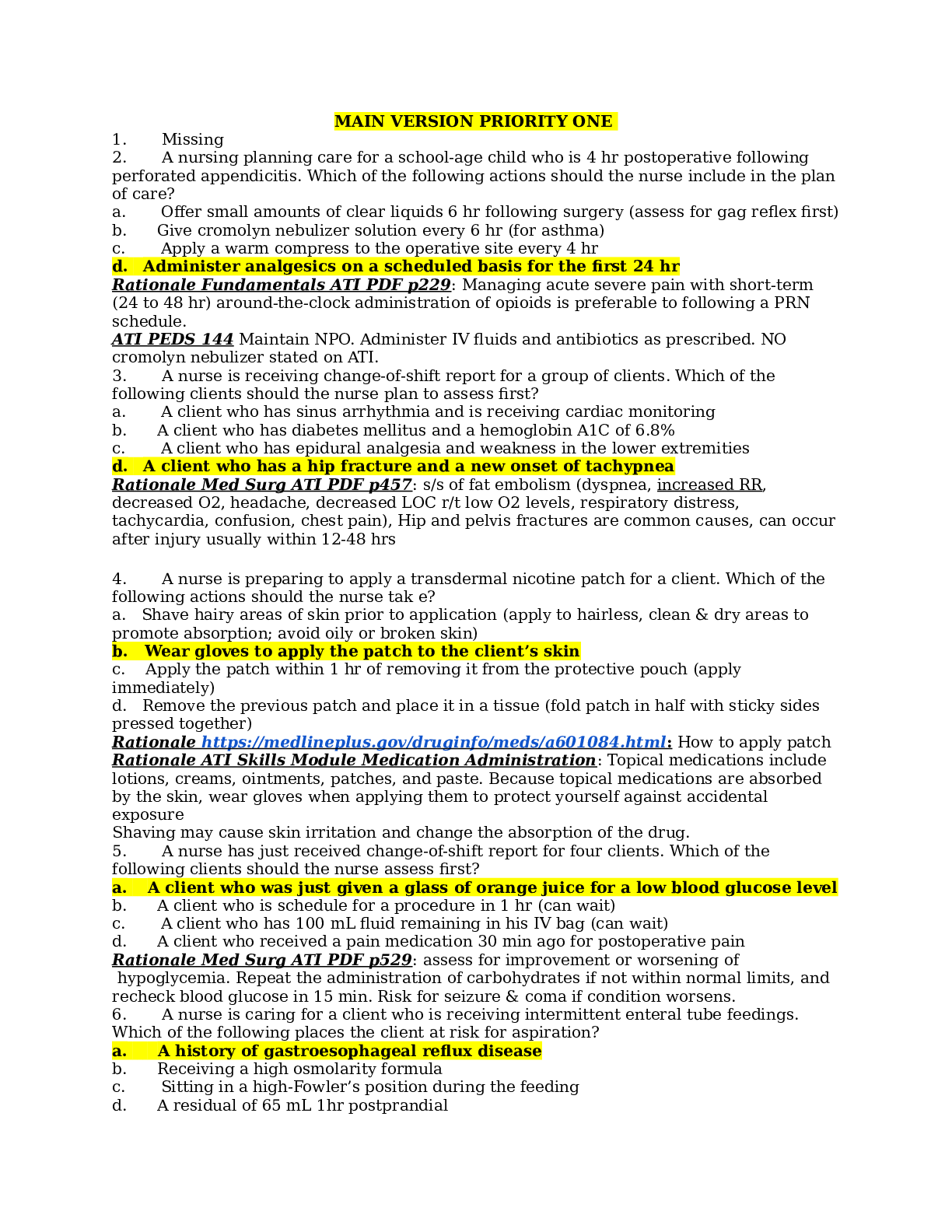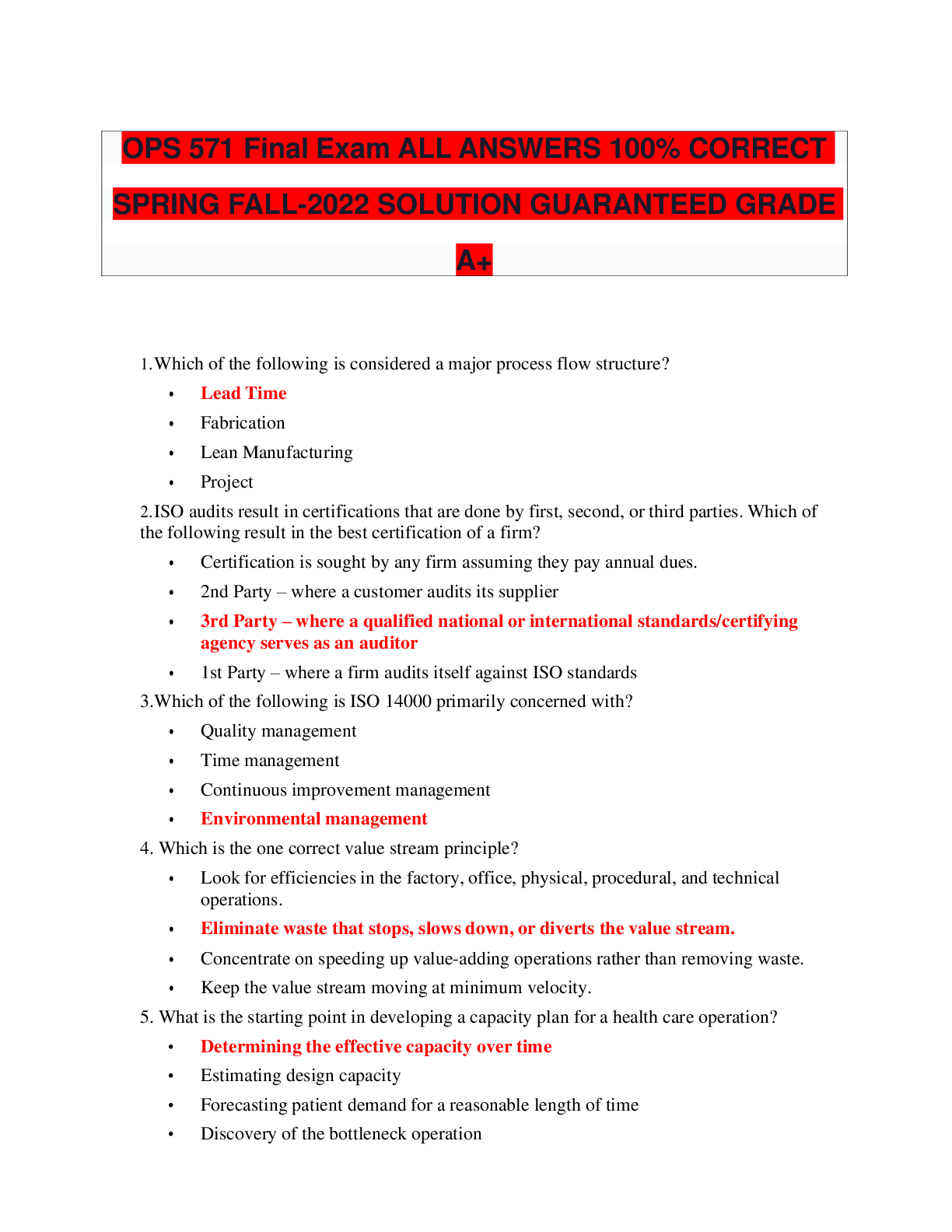*NURSING > EXAM > Test Bank for Nursing Leadership and Management Retakes_ 2021/ answered and graded 100% CORRECT GUAR (All)
Test Bank for Nursing Leadership and Management Retakes_ 2021/ answered and graded 100% CORRECT GUARANTEED GRADE A+
Document Content and Description Below
1. According to Henri Fayol, the functions of planning, organizing, coordinating, and controlling are considered which aspect of management? a. Roles b. Process c. Functions d. Taxonomy ANS: ... B, The management process includes planning, organizing, coordinating, and controlling. Management roles include information processing, interpersonal relationships, and decision making. Management functions include planning, organizing, staffing, directing, coordinating, reporting, and budgeting. A taxonomy is a system that orders principles into a grouping or classification. 2. Which of the following is considered a decisional managerial role? a. Disseminator b. Figurehead c. Leader d. Entrepreneur ANS: D, The decisional managerial roles include entrepreneur, disturbance handler, allocator of resources, and negotiator. The information processing managerial roles include monitor, disseminator, and spokesperson. The interpersonal managerial roles include figurehead, leader, and liaison. 3. A nurse manager meets regularly with other nurse managers, participates on the organizations committees, and attends meetings sponsored by professional organizations in order to manage relationships. These activities are considered which function of a manager? a. Informing b. Problem solving c. Monitoring d. Networking ANS: D, The role functions to manage relationships are networking, supporting, developing and mentoring, managing conflict and team building, motivating and inspiring, recognizing, and rewarding. The role functions to manage the work are planning and organizing, problem solving, clarifying roles and objectives, informing, monitoring, consulting, and delegating. 4. A nurse was recently promoted to a middle-level manager position. The nurses title would most likely be which of the following? a. First-line manager b. Director c. Vice president of patient care services d. Chief nurse executive ANS: B, A middle-level manager is called a director. A low managerial- level job is called the first-line manager. A nurse in an executive level role is called a chief nurse executive or vice president of patient care services. 5. A nurse manager who uses Frederick Taylors scientific management approach, would most likely focus on which of the following? a. General principles b. Positional authority c. Labor productivity d. Impersonal relations ANS: C, The area of focus for scientific management is labor productivity. In bureaucratic theory, efficiency is achieved through impersonal relations within a formal structure and is based on positional authority. Administrative principle theory consists of principles of management that are relevant to any organization. 6. According to Vrooms Theory of Motivation, force: a. is the perceived possibility that the goal will be achieved. b. describes the amount of effort one will exert to reach ones goal. c. describes people who have free will but choose to comply with orders they are given. d. is a naturally forming social group that can become a contributor to an organization. ANS: B, According to Vrooms Theory of Motivation, Force describes the amount of effort one will exert to reach ones goal. Valence speaks to the level of attractiveness or unattractiveness of the goal. Expectancy is the perceived possibility that the goal will be achieved. Vrooms Theory of Motivation can be demonstrated in the form of an equation: Force = Valence Expectancy (Vroom, 1964). The theory proposes that this equation can help to predict the motivation, or force, of an individual as described by Vroom. 7. According to R. N. Lussier, motivation: a. is unconsciously demonstrated by people. b. occurs externally to influence behavior. c. is determined by others choices. d. occurs internally to influence behavior. ANS: D, Motivation is a process that occurs internally to influence and direct our behavior in order to satisfy needs. Motivation is not explicitly demonstrated by people, but rather it is interpreted from their behavior. Motivation is whatever influences our choices and creates direction, intensity, and persistence in our behavior. 8. According to R. N. Lussier, there are content motivation theories and process motivation theories. Which of the following is considered a process motivation theory? a. Equity theory b. Hierarchy of needs theory c. Existence-relatedness-growth theory d. Hygiene maintenance and motivation factors ANS: A, The process motivation theories are equity theory and expectancy theory. The content motivation theories include Maslows hierarchy of needs theory, Aldefers existence- relatedness-growth (ERG) theory, and Herzbergs hygiene maintenance factors and motivation factors. 9. The theory that includes maintenance and motivation factors is: a. Maslows hierarchy of needs. b. Herzbergs two-factor theory. c. McGregors theory X and theory Y. d. Ouchis theory Z. ANS: B, The two-factor theory of motivation includes motivation and maintenance factors. Maslows hierarchy of needs includes the following needs: physiological, safety, security, belonging, and self-actualization. In theory X, employees prefer security, direction, and minimal responsibility. In theory Y, employees enjoy their work, show self-control and discipline, are able to contribute creatively, and are motivated by ties to the group, organization, and the work itself. The focus of theory Z is collective decision making and long-term employment that involves slower promotions and less direct supervision. 10. A nurse is appointed to a leadership position in the local hospital. The nurses position would be considered which of the following? a. Informal leadership b. Formal leadership c. Leadership d. Management ANS: B, Formal leadership is based on occupying a position in an organization. Informal leadership is shown by an individual who demonstrates leadership outside the scope of a formal leadership role or as a member of a group. Leadership is a process of influence whereby the leader influences others toward goal achievement. Management is a process to achieve organizational goals. 11. A nursing instructor is evaluating whether the nursing students understand the three fundamental qualities that leaders share. According to Bennis and Nanus, the fundamental qualities of effective leaders are: a. guided vision, passion, and integrity. b. knowledge of self, honesty, and maturity. c. intelligence, self-confidence, and determination. d. honesty, self-awareness, and sociability. ANS: ABennis and Nanus list guided vision, passion, and integrity as fundamental qualities of effective leaders. Knowledge of self, honesty and maturity; intelligence, self-confidence and determination; self-awareness and sociability are all desirable traits in leaders as well as in others. 12. The six traits identified by Kirkpatrick and Locke that separate leaders from non-leaders were: a. respectability, trustworthiness, flexibility, self-confidence, intelligence, sociability. b. self-confidence, progression of experiences, influence of others, personal life factors, honesty, drive. c. intelligence, self-confidence, determination, integrity, sociability, honesty. d. drive, desire to lead, honesty, self-confidence, cognitive ability, knowledge of business. ANS: D, Research by Kirkpatrick and Locke concluded that leaders possess six traits: drive, desire to lead, honesty, self- confidence, cognitive ability, and knowledge of the business. Woods identified five dominant factors that influenced leadership development: self-confidence, innate qualities, progression of experience, influence of significant others, and personal life factors. Stogdill identified the following traits of a leader: intelligence, self- confidence, determination, integrity, and sociability. Murphy and DeBack identified the following leader characteristics: caring, respectability, trustworthiness, and flexibility. 13. A nurse manager who uses a leadership style that is participatory and where authority is delegated to others is most likely using which of the following leadership styles? a. Autocratic b. Democratic c. Laissez-faire d. Employee-centered ANS: B, Democratic leadership is participatory, and authority is delegated to others. Autocratic leadership involves centralized decision making, with the leader making decisions and using power to command and control others. Laissez-faire leadership is passive and permissive, and the leader defers decision making. Employee-centered leadership focuses on the human needs of subordinates. 14. A characteristic of the consideration dimension of leadership behavior is: a. focus on the work to be done b. focus on the task. c. focus on production. d. focus on the employee. ANS: D, The leadership dimension of consideration involves activities that focus on the employee. Initiating structures of leadership involves an emphasis on the work to be done, and a focus on the task and production. 15. The leadership theory that considers follower readiness as a factor in determining leadership style is: a. contingency. b. path goal. a. situational. c. charismatic. ANS: C, Situational leadership considers the follower readiness as a factor in determining leadership style. Contingency theory views the pattern of leader behavior as dependent on the interaction of the personality of the leader and the needs of the situation. In path goal theory, the leader works to motivate followers and influence goal accomplishment. Charismatic leadership has an inspirational quality that promotes an emotional connection from followers. 16. In contingency theory, the feelings and attitudes of followers regarding acceptance, trust, and credibility of the leader are called: a. task structure. b. position power. c. low task structure. d. leader-member relations. ANS: D, In contingency theory, leader-member relations are the feelings and attitudes of followers regarding acceptance, trust, and credibility of the leader. Task structure of contingency theory means the degree that work is defined, with specific procedures, explicit directions, and goals. Low task structure involves work that is not routine, predictable, or clearly defined. Position power in contingency theory is the degree of formal authority and influence associated with the leader. REF: FIEDLERS CONTINGENCY THEORY 17. In situational theory, a telling leadership style is considered: a. high task, high relationship behavior. b. high task, low relationship behavior. c. low task, high relationship behavior. d. low task, low relationship behavior. ANS: B, A telling leadership style is high task behavior and low relationship behavior. A high task, high relationship style is called a selling leadership style. A low task and high relationship style is called a participating leadership style. A low task and low relationship style is called a delegating leadership style. REF: HERSEY AND BLANCHARDS SITUATIONAL THEORY 18. A nursing group has been very successful in achieving its goals even though the group has lacked leadership. Which of the following factors is probably most responsible for the groups success in goal achievement? a. Life experience b. Extrinsic satisfaction c. Informal organizational structures d. Cohesive groups ANS: D, Substitutes for leadership are variables that eliminate the need for leadership or nullify the effect of the leaders behavior. These include cohesive groups, work experience, intrinsic satisfaction, formal organizational structures, professionalism, indifference to rewards, routine tasks, feedback provided by the task, rigid adherence to rules, role distance, and low position power of the leader. REF: SUBSTITUTES FOR LEADERSHIP 19. The new nurse manager of a medical unit focuses on day-to- day operations and short-term goals, while the nurse manager of the mental health unit is committed to the vision that empowers the staff. The manager of the medical unit would most likely be considered which type of leader? a. Transformational leader b. Charismatic leader c. Transactional leader d. Autocratic leader ANS: C, A transactional leader focuses on operations and short-term goals. A transformational leader inspires and motivates others to excel and participate in a vision that goes beyond self-interests. A charismatic leader displays self-confidence and strength in convictions and communicates high expectations. An autocratic leader makes decisions and uses power to command and control others. REF: TRANSFORMATIONAL LEADERSHIP THEORY 20. The nursing staff perceive the newly hired Chief Nurse Administrator as a leader who is committed to a vision that empowers others. The Chief Nurse Administrator is most likely employing which type of leader? a. Transformational leader b. Charismatic leader c. Transactional leader d. Autocratic leader ANS: A, A transformational leader empowers others. A charismatic leader has an appeal based on personal power. A transactional leader focuses on day-to-day operations. An autocratic leader has central power and does not empower others. REF: TRANSFORMATIONAL LEADERSHIP THEORY 21. The nurse manager on one of the hospital units views the staff as basically lazy and only motivated by threats and coercion. Which theory of motivation would support the managers beliefs? a. Theory W b. Theory X c. Theory Y d. Theory Z ANS: B, The Theory X view is that in bureaucratic organizations, employees prefer security, direction, and minimal responsibility. Coercion, threats, or punishment are necessary because people do not like their work to be done. REF: THEORY X AND THEORY Y 22. A group of new nurse managers is undergoing a series of management training sessions. Which statement by one of the nurse managers would indicate use of McClellands Model of Motivation? McClellands Model focuses on: a. achievement, power, and affiliation. b. growth needs, relatedness needs, and existence needs. c. collective decision making, quality circles, and mentoring. d. self-actualization needs, safety and security needs, and self-esteem needs. ANS: A, McClellands Model of Motivation focuses on achievement, power, and affiliation. Growth needs, relatedness needs, and existence needs are aspects of Adlers model. Collective decision making, quality circles, and mentoring are the focus of Ouchis model. Self-actualization needs, safety and security needs, and self- esteem needs are reflected in Maslows model. REF: TABLE 1-1 NURSING LEADERSHIP CHARACTERISTICS AND ROLE ACTIVITIES 23. A nurse manager finds two employees arguing about the assigned schedule. Which role would be appropriate for the nurse manager to implement at this time? a. Advocate role b. Interpersonal role c. Decision-making role d. Information-processing role ANS: C, The decision-making role of a nurse manager would include being an entrepreneur, handling disturbances, and allocating resources. The information-processing role involves managing the information that the people need. The interpersonal role focuses on functioning as a figurehead, leader, or liaison. In the advocate role, the nurse manager would focus on supporting employee rights. REF: MANAGERIAL ROLES 24. A nurse manager who implements the bureaucratic management style will most likely do which of the following? a. Emphasize efficiency b. Use explicit rules and regulations for governing activities c. View the individual worker as the source of control, motivation, and productivity d. Expect unity of command and direction ANS: B, Bureaucratic management focuses on the use of explicit rules and regulations for governing activities. The human relations approach views the individual worker as the source of control, motivation, and productivity. Administrative principles focus on unity of command and direction. REF: BUREAUCRATIC MANAGEMENT 25. The nursing supervisor has traditionally made rounds at the same time each day. When the supervisor visits each unit, the staff appear to be extremely busy even when the census is very low. Today the supervisor visited a unit two hours early and found several staff members watching television and drinking coffee in the visitors lounge. The supervisor recognizes that the staffs previous behavior have been a result of which of the following? a. Coincidence b. Hawthorn effect c. Diligence of staff d. Time management ANS: B, Because the nursing supervisor traditionally made rounds at the same time each day, the staff members were prepared for the visit. When the supervisor arrived unexpectedly, the staff members were most likely caught off-guard. The Hawthorn effect occurs when recognition that one is being studied or observed results in a change in behavior. Coincidence, diligence of staff, and time management would not account for the dramatic change in behavior. REF: HUMAN RELATIONS MULTIPLE RESPONSE 1. A nurse manager who structures her approach on the McClelland Model of Motivation would most likely focus on which of the following? Select all that apply. a. Power b. Affiliation c. Quality circles d. Achievement e. Mentoring f. Collective decision making ANS: A, B, D, McClellands Model of Motivation focuses on power, achievement, and affiliation. Ouchis model focuses on quality circles, collective decision making, long-term employment, and mentoring. REF: FIGURE 1-1 KEY LEADERSHIP DIMENSIONS 2. A nurse manager who follows Herzbergs Two-Factor Theory would recognize that which of the following are hygiene- maintenance factors? Select all that apply. a. Job security b. Advancement opportunities c. Working conditions d. Relationships with others e. Status f. Achievement ANS: A, C, D, E, Herzbergs hygiene-maintenance factors include status, job security, quality of supervision, safe and tolerable work conditions, and relationships with others. Advancement opportunities, achievement, recognition, the work itself, personal growth, and responsibility are all motivation factors. 3. A nursing instructor determines that the nursing students understand the concept of knowledge worker if the students describe which of the following tasks of the knowledge worker? Select all that apply. a. Provide service b. Represent the organization c. Interact with the customer d. Focus on personal, life-long goals and achievement e. Bring expert knowledge f. Accomplish goals ANS: A, B, C, E, F, According to Peter Drucker, knowledge workers provide service, interact with the customer, represent the organization, and accomplish its goals. These workers bring specialized, expert knowledge to the organization, and they are valued for what they know. The knowledge worker focuses more on organizational goals than personal goals. REF: H1: KNOWLEDGE WORKERS Chapter 2: The Health Care Environment MULTIPLE CHOICE 1. Which of the following individuals observed that noise, food, rest, light, fresh air, and cleanliness were instrumental in health and illness patterns? a. W. Edwards Deming b. Florence Nightingale c. Isabel Hampton Robb d. Dorothea Dix ANS: B, Florence Nightingale was the first to observe that noise, food, rest, light, fresh air, and cleanliness were instrumental in health and illness patterns. W. Edwards Deming is known for his contribution to continuous performance improvement, and Isabel Hampton Robb was the first president of the ANA and a pioneer in nursing education. Dorothea Dix is best known for her patient advocacy, particularly in the areas of improved conditions for jails and mental asylums. REF: HISTORY OF HEALTH CARE 2. A nursing instructor asks a student what discoveries are attributable to Florence Nightingale. The instructor determines that further teaching is needed if the student responds: a. the need to monitor health care practitioners. b. the importance of structuring hospitals around care. c. the importance of collecting and using data for quality assessment. d. the importance of being informed regarding the activities of government policymakers. ANS: B, Nightingale is credited with a variety of discoveries related to health care such as the importance of structuring hospitals around nursing care (not merely care), the need to monitor/be informed regarding health care practitioners and government policymakers, and the importance of collecting and using data for quality assessment. REF: STRUCTURING HOSPITALS AROUND NURSING CARE 3. A new graduate wants to explore the three components of each heath care system before applying for a position. The graduate would plan to explore which of the following? a. Strategy, outcome, and performance b. Process, strategy, and opportunity c. Structure, process, and outcome d. Outcome, procedure, and structure ANS: C, The three simple elements of health care systems are structure (resources or structures required to deliver health care), process (quality activities, procedures, and tasks performed to deliver quality health care), and outcome(the results of good health care delivery). REF: ORGANIZATION OF HEALTH CARE 4. Which of the following organizations has set forth three primary goals for good health care? a. The Institute of Medicine b. The Centers for Disease Control and Prevention c. The Agency for Healthcare Research and Quality d. The World Health Organization ANS: D, The World Health Organization (WHO) has been a leading advocate of quality health care delivery, as evidenced by its three primary goals for what good health care should do. The Institute of Medicine (IOM) is best known for its quality data reports such as To Err Is Human (IOM, 1999), and the Centers for Disease Control and Prevention is a leading infection and disease agency in the United States. The Agency for Healthcare Research and Quality is another quality-based organization and produces reports such as the National Healthcare Disparities Report (NHDR). REF: ORGANIZATION OF HEALTH CARE 5. A nurse working on the unit budget would recognize that the resources needed to deliver quality health care such as nurses, practitioners, medical records, buildings, and pharmaceuticals are considered which aspects of health care? a. Process b. Structure c. Organization d. Practice ANS: B, The health care structure is comprised of the resources or structures needed to produce quality health care. Some of these structures or resources are human (staff and personnel) or physical (buildings or facilities). REF: ORGANIZATION OF HEALTH CARE 6. The human resource manager understands that an example of a quality performance outcome measure involves which of the following? a. Patient satisfaction b. Return on assets (ROI) c. Staff satisfaction d. Organizational climate ANS: C, An outcome for a quality performance measure related to human resources is staff satisfaction. Patient satisfaction is a clinical care outcome, and return on assets (ROI) is a financial management outcome. The organizational climate is a human resource process, as opposed to the outcome. REF: TABLE 2-1 EXAMPLES OF PERFORMANCE MEASURES BY CATEGORY 7. A nurse is on vacation visiting a number of countries. If the nurse becomes ill, in which country will the nurse most likely be hospitalized in a government hospital, with the government paying the bills. a. Canada b. New Zealand c. Taiwan d. Germany ANS: B, If the nurse became ill in New Zealand health care would be provided in a government hospital with the government paying the bills. Canada and Taiwan rely on private-sector providers, paid for by government-run insurance. Germany, the Netherlands, Japan, and Switzerland provide universal coverage using private doctors, private hospitals, and private insurance plans. REF: HEALTH CARE PAYMENT IN OTHER COUNTRIES 8. An instructor wants to determine if a group of nursing students know the important features related to the benefits of primary care. Which of the following responses by the students would indicate that further teaching is necessary? a. Care that is continuous b. Care that began at first contact with the patient c. Care that is integral d. Care that is community orientated ANS: C, The seven important features of primary care are care that is continuous, community oriented, comprehensive (not integral), coordinated, family centered, culturally competent, and begun at the first contact with the patient. REF: NEED FOR PRIMARY HEALTH CARE 9. A group of nursing students are given a test on Starfields (1998) foundations of primary care. Which of the following responses by the students describing the foundations of primary care would indicate that further teaching is necessary? a. Comprehensiveness b. Organization c. First contact d. Coordination ANS: B, According to Starfield (1998), both clinicians and patients need to work together to appropriately utilize services based upon these four foundations of primary care: first contact (conduct the initial evaluation and the plan for the dysfunction, treatment options, and health goals), longitudinality (maintaining the clinician-patient relationship continuously over time), comprehensiveness (managing the wide range of needs for each patient), and coordination (care is organized and integrated, thus eliminating duplication of services). REF: NEED FOR PRIMARY HEALTH CARE 10. Which agency/division is not a part of the U.S. Department of Health and Human Services? a. Food and Drug Administration (FDA) b. Centers for Disease Control and Prevention (CDC) c. Institute of Medicine (IOM) d. Indian Health Service (HIS) ANS: C, Some of the major divisions and agencies that comprise the U.S. Department of Health and Human Services are Food and Drug Administration (FDA), Centers for Disease Control and Prevention (CDC), Indian Health Service (HIS), Agency for Healthcare Research and Quality (AHRQ), Centers for Medicare and Medicaid (CMS), Health Resources and Services Administration (HRSA), and Substance Abuse and Mental Health Services Administration (SAMHSA). The Institute of Medicine (IOM) is not under the auspices of the U.S. Department of Health and Human Services. REF: THE FEDERAL GOVERNMENT 11. Which of the following was not identified as an area of health care disparities according to the 2008 National Healthcare Disparities Report? a. Age groups b. Socioeconomic groups c. Geographic areas d. Racial and ethnic populations ANS: A, The 2008 National Healthcare Disparities Report found that health care disparities often persist across socioeconomic groups, racial and ethnic populations, and geographic areas. The report also noted that across the process of care measures tracked, patients received the recommended care less than sixty percent of the time. REF: HEALTH CARE DISPARITIES 12. Which of the following is not one of the three key pieces of legislation that established national standards that states use to regulate health insurance? a. ELISA b. COBRA [Show More]
Last updated: 1 year ago
Preview 1 out of 316 pages
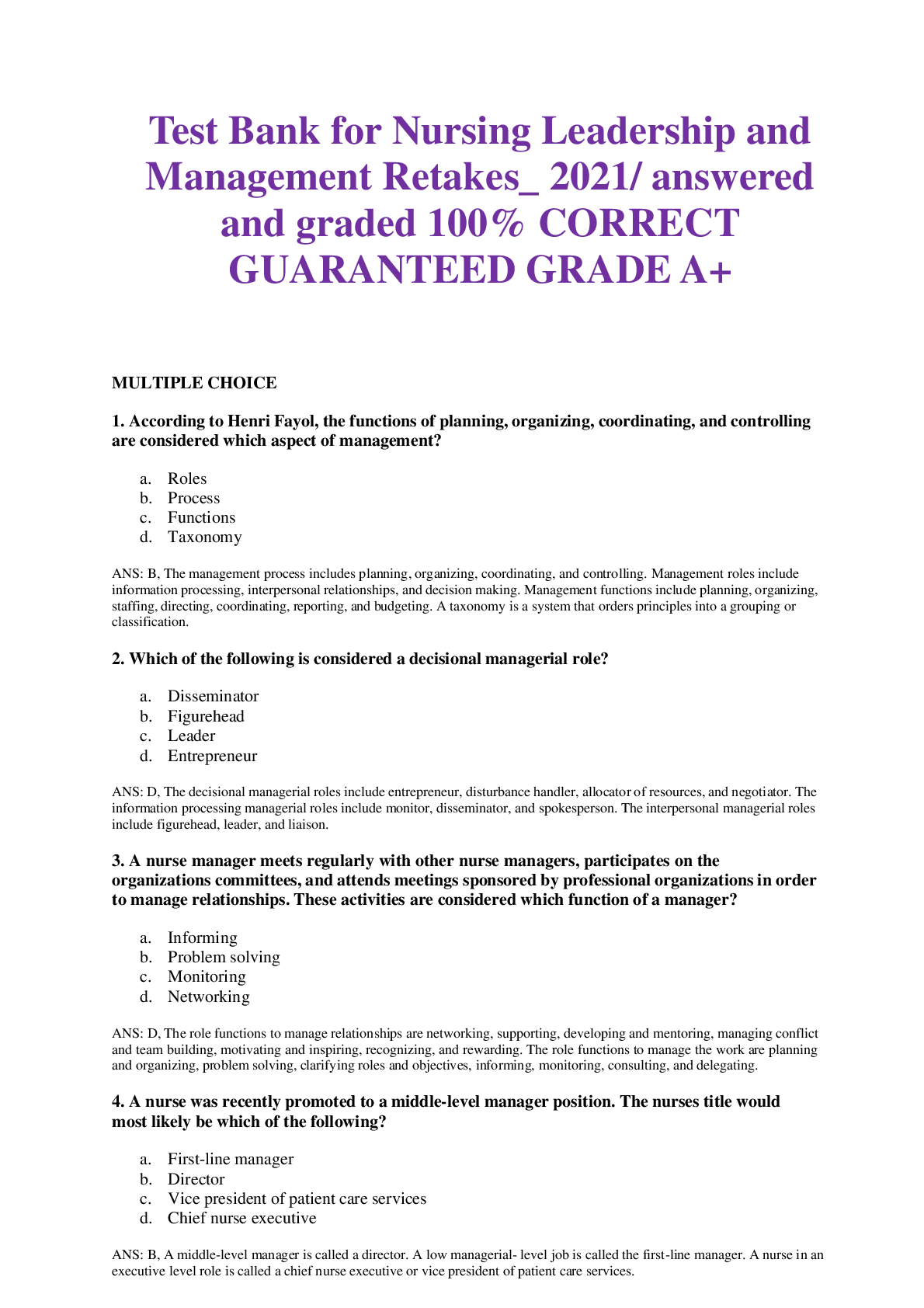
Reviews( 0 )
Document information
Connected school, study & course
About the document
Uploaded On
Oct 18, 2021
Number of pages
316
Written in
Additional information
This document has been written for:
Uploaded
Oct 18, 2021
Downloads
0
Views
38

